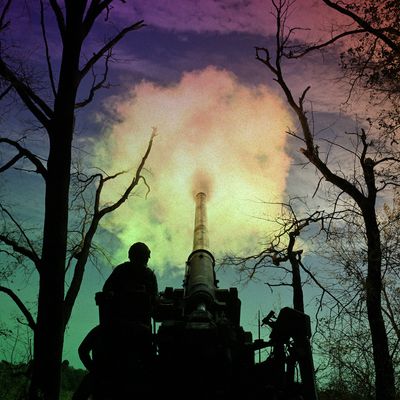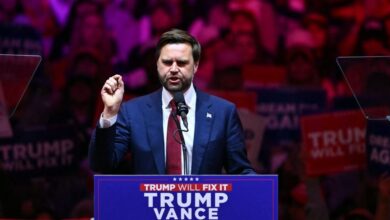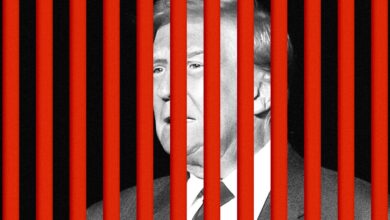

Photo: Genya Savilov/AFP via Getty Images
It has not been a good few months for Ukraine. Russia is slowly but steadily gaining ground in the country’s Donetsk region, where its forces bombard towns and cities, overwhelming an exhausted Ukrainian military. A regional war in the Middle East has eclipsed the refocused western allies elsewhere. The prospect of another Trump presidency, and the political unpredictability that would entail, looms large. Yet Michael Kofman, a senior fellow at the Carnegie Endowment for International Peace who has written and commented extensively on the war, thinks the narrative of impending Russian domination is too simple. I spoke with him about the state of play on the battlefield, Ukraine’s surprise incursion into Russian territory, and Vladimir Putin’s recent nuclear saber-rattling.
Thanks for speaking with me again for the third time in the last two years.
Sure, man. What did you want to talk about today?
This may come as a surprise to you, but the Russia-Ukrainian War is the main topic.
Nobody calls me for my cooking recipes.
We can do a section on that at the end if you want.
I’m an avid fan of barbecue.
This is how the Washington Post recently described the larger dynamic in Ukraine: “Enemy troops are storming the battlefields in small teams that minimize detection and make return fire difficult, backed by superior quantities of artillery and drones. Russia has also improved its battlefield communications, helping coordinate attacks and while losses are staggering, Ukrainian soldiers have said the Russians have the numbers to keep up the pressure and Western aid isn’t making up the equipment deficit.” Does that strike you as pretty much an accurate depiction of where things are on the front?
I would quibble with some pieces of that, but in general, I think it’s fair. My own view is that Russia has enjoyed a materiel advantage and the overall initiative for the past year. That advantage hasn’t proven decisive, at least not sufficiently enough to enable operational-size breakthroughs. But Russian forces have been steadily pressing the Ukrainian military in Donetsk and in other parts of the front — for example, by Kupiansk. And despite the costs, as you mentioned, both to materiel and personnel, they’ve been making fairly steady incremental gains.
Last week, the town of Vuhledar, in Donetsk, officially fell after being under attack for more or less the entire war. Pokrovsk, to the west, may be in Russia’s sights over the next few weeks. How far do you think they can go in the near future? And to what extent are they limited by the impending winter?
Weeks is unlikely for Pokrovsk, but I think it will become the site of one of the next major battles. Russian forces have focused on trying to flank south of the city right now, taking the town of Ukrainsk, attempting to close a pocket by Kurakhove, and most recently taking Vuhledar. I think we are seeing both sides position for the seizure of Pokrovsk. The Russian military is now pressing Ukrainian defensive lines outside the city, and the eastern half of the city is within artillery range. Pokrovsk is an important logistics hub, although its military value, I think, is going to rapidly decline at this stage. Russian forces are also pushing at Toretsk and around Chasiv Yar. It’s clear that their primary objective remains the capture of the rest of the Donetsk region. I think one of the main outstanding questions is to what extent can the Ukrainian military stabilize the front and exhaust the Russian offensive over the course of this fall and winter.
Republicans held up the last American aid package for months before it finally passed, and by that point Russian troops were already making some advances. How important was that delay in terms of explaining Ukraine’s position now?
I would say it was a very significant factor, but not the only one. I want to draw your attention to three interrelated factors that more or less are causal of how we ended up to where we are today. The first is of course a delay in a supplemental from September of 2023 to middle of spring of this year. That made it very difficult to engage in any sort of planning and formulation of joint strategy with the Ukrainian military, since we didn’t know what resources they would be working with. And of course that led to a significant deficit of artillery ammunition over the course of the fall and winter and shortages across the front in other forms of materiel support.
That said, the Ukrainian leadership dithered on mobilization and took an exceedingly long time to begin addressing the issues of manpower and a lack of fortifications at the front from fall of last year to approximately this spring. After passing two mobilization laws — or, more aptly, changes to the current mobilization laws — and having begun a nationwide fortification construction program over the course of the winter and spring, there’s been marked improvement. But the first-order problem Ukrainian forces have had is a deficit of manpower, especially infantry, followed by issues with fortifications and munitions.
Because Ukraine suffered from a deficit of manpower, it was very difficult to rotate units without additional brigades, which they’ve been forming over the course of this summer and fall. That led to a general depletion of the force, a degree of exhaustion, and also incohesiveness in parts of the effort as brigades were forced to detach battalions and other units to send them to particularly troublesome parts of the front in order to essentially firefight or prevent Russian advances. And so it was a combination of issues with fortifications, a lack of well-prepared defense, a deficit of munitions and materiel as provided by the United States and other western countries. But also many of the issues have to do with mobilization and following mobilization, the need to substantially revamp training and improve Ukraine’s absorption capacity, actually training personnel and either generating new formations, standing up new brigades — or being able to effectively replace losses at the front line.
Considering the position they’re in now, those challenges sound pretty steep.
While the situation looked quite precarious this spring, by summer it actually began improving among all those factors. Now, provision of materiel assistance wasn’t going to give Ukraine parity in terms of artillery fires but not substantially reduce the Russian artillery advantage at the front. Mobilization began to yield significantly increased numbers of personnel, although there’s issues in absorption and quality, and Ukraine’s campaign to build fortifications was starting to show some results, although there are nuances there as well. That said, Ukraine’s offensive in Kursk has, from my point of view, increased the cone of uncertainty as we look out on the prospects over the course of this winter and next spring. Ukraine had been, I thought, on track to hold Russia to relatively incremental gains, or let’s say avoid any major collapse on the front line, when I was last there this summer.
How did you find the mood on the battlefield, then?
I was last in Ukraine at the end of June and my impression had been actually more positive compared to this past winter and spring. Ukrainian forces had effectively halted the Russian offensive at Kharkiv. In looking across the front, while the situation was difficult, it appeared to be steadily improving and it looked as though the worst-case outcomes could be avoided later this year. The primary problem, as I saw it this summer, was perhaps less the situation at the front line and more the nationwide deficit of air defense, missile defense, versus the growing threat posed by the Russian strike campaign. Over the course of the spring, Russia had destroyed or degraded a substantial portion of Ukraine’s power-generation capacity. Back then, and I think this is much more salient even now, Ukraine faced a harsh winter with much of the preparation focused on how to ensure electricity supply to Ukraine’s main city, to the front cities, to the front lines, because the level of damage being inflicted by Russian strikes against Ukrainian critical structure, from my point of view, was likely more significant than the day-to-day shifts at the front line.
You mentioned Ukraine’s incursion into Russian territory at Kursk. The plan seemed to be to divert Russian troops from the east and south of Ukraine, but that hasn’t really happened. Do you see it as a failure of strategy?
From my point of view, the Kursk cooperation was a bold gamble. It technically was a success and not only did it improve morale, but it, at least for a period of time, changed the conversation from the prevailing doom and gloom, particularly in the media, to give a sense that Ukraine still had options, that it still had the capacity to restore offensive potential to the force, that it was still capable of surprising us. And so I think it had a degree of, it to some degree revived hopes and expectations and certainly gave a more dynamic sense.
From a more operational perspective, I don’t think Kursk was that successful because if the primary goal was to shift significant Russian forces from their advances in and around Pokrovsk, Toretsk, Chasiv Yar, this did not take place. And while Russia did redeploy forces from within the country and from more stable or less active parts of the front line, it did not lead to a loss of Russian momentum. If anything, the Russian rate of gain accelerated over the course of August and September, arguably at a pace not seen since spring of 2022. The last question, and this one I think is worth discussing and debating, is to what extent Kursk was a political success. One of the tests of that would be the results of Ukrainian leadership’s visit last week to the United States and whether or not this will yield any significant changes in U.S. policy, the formulation of a new strategy or new plan, or the provision of greater materiel assistance and support.
There’s also an important meeting that’s going to take place in Ramstein on October 12, so to some extent, I reserve judgment. My own view is that so far I’ve not seen significant political results from the operation. That said, that I understand it, at least I interpret it as a calculated risk. And at a bare minimum, I suspect that what motivated the Kursk offensive was concern, certainly among the Ukrainian leadership that they might be pressed into negotiating a cease-fire from a position of relative weakness, particularly looking at the trajectory of the U.S. election, if you think back to June when the planning for this offensive was likely formulated.
From the beginning, analysts have said that Russia’s big advantage is their numbers. As in past wars, they can send wave after wave of soldiers into battle, and they seem to have little regard for those soldiers’ lives. From what I’ve read, the army has learned from some of their failures in the past couple years, and some of the new soldiers are being more strategic. But they still have the meat-grinder mentality. They’ve captured towns, but at a huge cost in men. Is there any limit to the Russian supply of troops? Do you see that advantage fading at all, whether because of diminishing numbers or political backlash?
It’s a good question. Russia’s advantage has been the ability to withstand very high levels of attrition because of the materiel and manpower resources they have, and also their significant capacity for mobilization of resources on a national scale — that is, defense industrial production, manpower recruitment, and the like.
But Russia’s actually operating under very significant constraints. And if anything, its advantage on the battlefield is likely to decline as we get into this winter and look further ahead into 2025. First, in terms of equipment, the Russian military has been sustaining very high levels of loss that are principally being replaced by Soviet-era stocks — not entirely, but at this stage, Russia is eating through its Soviet legacy, and its rate of equipment production is quite low relative to the numbers being lost on the battlefield.
This doesn’t mean that Russia is going to run out of armored fighting vehicles. What it does mean is that the Russian military has increasingly been forced to adjust tactics to minimize their losses, and that also reduces their ability to achieve any operationally meaningful breakthroughs. When you look at manpower, the Russian government has significantly increased the payouts and benefits to recruit personnel. The reason for that is straightforward. It’s clear that at this rate of loss, the Russian contract recruitment campaign is unable to keep up. This too does not mean that Russia is going to run out of manpower, but it’s clear that they’re struggling, and they are not likely to be able to sustain this pace of operations, staying on the offensive with this rate of loss.
Which could mean there’s an incentive for both sides to come to the negotiating table. Perhaps a bit more of an incentive than there was a year ago?
The way I would put it is that the Russian military is actually operating under significant constraints. And given the likely decline in the relative advantage at the front line, Russia’s potential negotiating position actually isn’t all that strong. And if you look at other factors, particularly macroeconomic ones, while Russia has the resources to sustain the war in the near term, looking just a bit beyond that, you see a fairly problematic picture in terms of the rate of inflation in Russia’s overheating economy, the deficit of skilled labor, because the state is pulling workers into the defense industry and contracting them to fight in the war, the steady depletion of Russia’s liquid reserves, and the fact that much of the budget is tied to the current oil price. The economic picture for Russia isn’t particularly rosy. And it is an effort to keep in the air, to juggle a number … to keep in the air, juggle several different parts of this equation that may not be sustainable. And this too must at some point weigh on the Russian leadership’s mind.
Ukraine has always said it won’t give up any land that Russia has taken from it since 2014, and that has come to seem as more and more far-fetched as Russia gains. Do you think they’d eventually cede some of what they’ve lost?
I think a settlement is unlikely in the sense of a political settlement that resolves the issues that led to this war. If anything, there could be a cease-fire, but the challenge for Ukraine is how to achieve war termination on favorable terms and avoid having to negotiate from a position of weakness that would have conditions imposed upon it that I think Ukrainians would find fundamentally unacceptable. And secondarily, how to attain security guarantees from the West? Because any cease-fire agreement is very likely to yield a rearmament period, which could prove more beneficial to Russia. That matter can be debated, but nonetheless, it’s not likely to lead to any sort of lasting peace, and it would leave Ukraine quite vulnerable. And therefore, Ukraine’s leadership is dealing with a dilemma.
A cease-fire agreement with Russia is unlikely to be worth the paper it’s written on. And as long as Vladimir Putin’s in power, he’s likely to continue to seek the Ukraine’s destruction. So one thing we should consider is that there’s a fair chance that how this war ends, or more accurately pauses, is likely to lead to a third war.
Oh, great.
Let me add to that last thought. It’s important to not just seek a cease-fire or an agreement for agreement’s sake, because it may not resolve either Ukraine’s concerns or the West’s concerns more broadly when looking at the future of European security. That said, since 2023 and the failure of Ukraine’s summer offensive, I think there’s been a very observable drift in both American and western strategy writ large in this war, and a lack of good answers on how to achieve war termination on favorable terms for Ukraine, or to put more simply, how they even effectively compel Russia to arrive at the negotiating table. So that’s what much of the discussion has been about in recent months.
One thing that has been true from the beginning of this war is that Ukraine asks the Biden administration for something, whether it’s weapons or permission to strike certain locations. The U.S. says no, Ukraine keeps asking, and the U.S. eventually says yes. The latest example is Ukraine wanting to strike targets deeper inside Russia with long-range artillery. So far, they’ve been denied, but that might change. If they did get the green light to do that, how much would it matter?
First, regarding the history you mentioned, I think it’s been a very unhelpful dynamic that capabilities that could have benefited Ukraine’s war effort have not been deployed at scale at a time when they could have been operationally relevant. They’ve often been released after the fact when the political pressure mounted, but their introduction into the war hasn’t been timed or sequenced in order to achieve any significant effects.
And the reason I raise this is that most of the capabilities have their greatest impact when they’re first introduced to scale, and then they drive a cycle of adaptation and development of counters by the opponent, which is why introducing new types of weapon systems or technology in small numbers, just trickling them onto the battlefield, usually doesn’t yield that much in terms of its net effect on the war. And when done out of sequence, while of course it does have an effect, it’s not an effect that can substantially impact the course of the war.
To your question on the restrictions of Ukraine’s ability to use long-range strike capabilities in Russia, I think a cogent case could be made that a campaign of this type could potentially compel Russia to hold its strikes on Ukrainian critical infrastructure, or that it could inflict sufficient levels of damage against Russian logistics and supporting military infrastructure to slow the momentum of the current Russian offensive and potentially buy Ukraine time. So there is a strong case that could be made for the benefits.
That said, much depends on the actual availability of missiles that could be provided by the United States and by other countries. And my own suspicion is if reservations exist, it’s much more of a cost-benefit analysis and potential concerns about horizontal escalation. My own view is that the debate has centered on what is now a fairly arbitrary line after a change of restrictions to enable Ukraine to use HIMARS systems to strike into Russia in Belgorod and Kursk and an extensive strike campaign that has been conducted with both U.S. and other European capabilities in Crimea.
Putin has been making noises about nuclear weapons again, saying that if a western country does what we just discussed and gives permission for Ukraine to launch long-range artillery attacks, that could now be grounds for a nuclear response. Do you make anything of this threat?
First, from what I understand, these are public statements about proposed changes to Russian nuclear doctrine. But I think folks should understand that this is primarily about signaling and a change to declaratory policy. Therefore, I don’t think that they’re going to garner much of a reaction. Declaratory policy is typically intended to deter opponents and, for lack of a better word, to scare them or to induce caution.
And the declaratory policy is not a defense-planning document, nor is it something that Putin will remotely care about if it ever comes to making such decisions. In short, this is primarily about signaling and posturing more than anything else. And I think it is very much driven by the Russian fear that over the course of this war, they’ve been effectively salami-sliced by the United States and our allies across a host of thresholds or perceived red lines — and that the deterrent effect of Russian statements or claims has weakened tremendously over the course of this war.
Ukraine has called that out as saber-rattling all along, and they’ve proven correct so far.
I would say that could be a fair reading of how we got here. My own view is that concern over escalation did have a significant effect early on in the war in 2022 in delaying western materiel support and slowing down decision-making on a host of issues and our overall involvement in supporting Ukraine’s war effort. It became far less significant once we started looking at the latter part of 2022.
But we should not be dismissive of the potential effect it might’ve had in that initial, fairly decisive period of the war. On the other hand, I think history will show that the United States and other western countries steadily expanded both materiel support and support in terms of intelligence and planning to the Ukrainian military far above and beyond what they had ever considered in the early periods of the war. So on the one hand, it was slow and late, and on the other, it’s hard to look at the trajectory of western assistance to Ukraine and necessarily read that as a deterrent success story for Russia. If anything, Russian leadership at this point appears increasingly cornered.
This interview has been edited for length and clarity.
Source link




